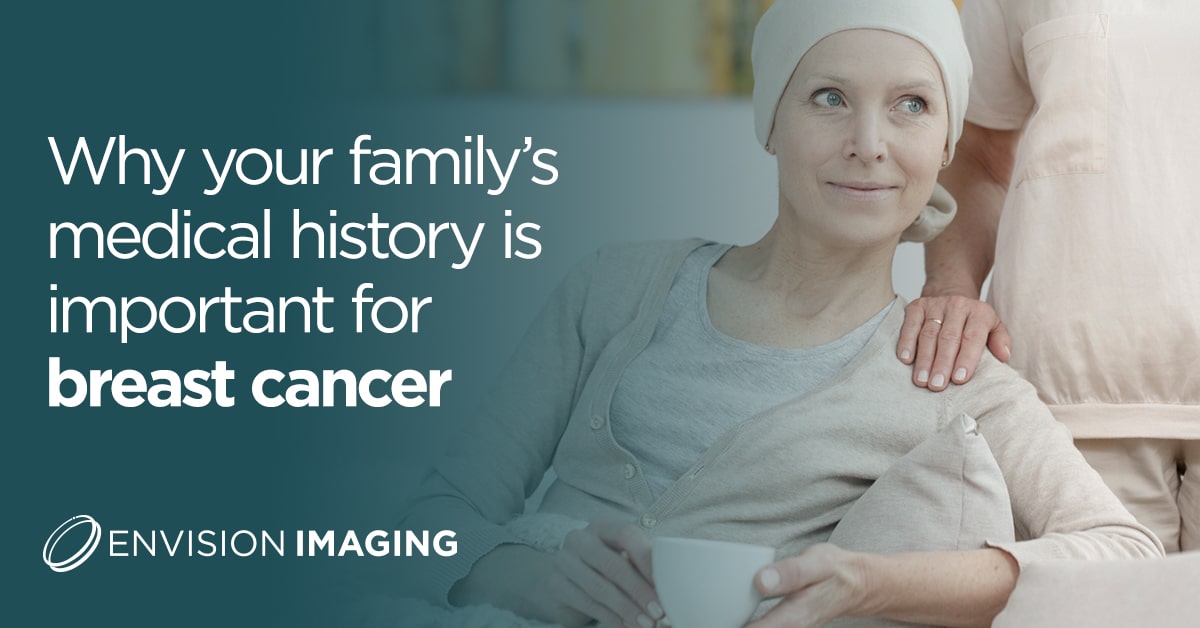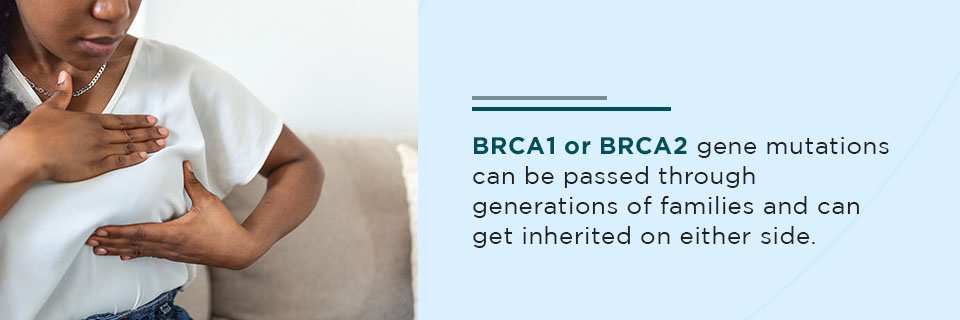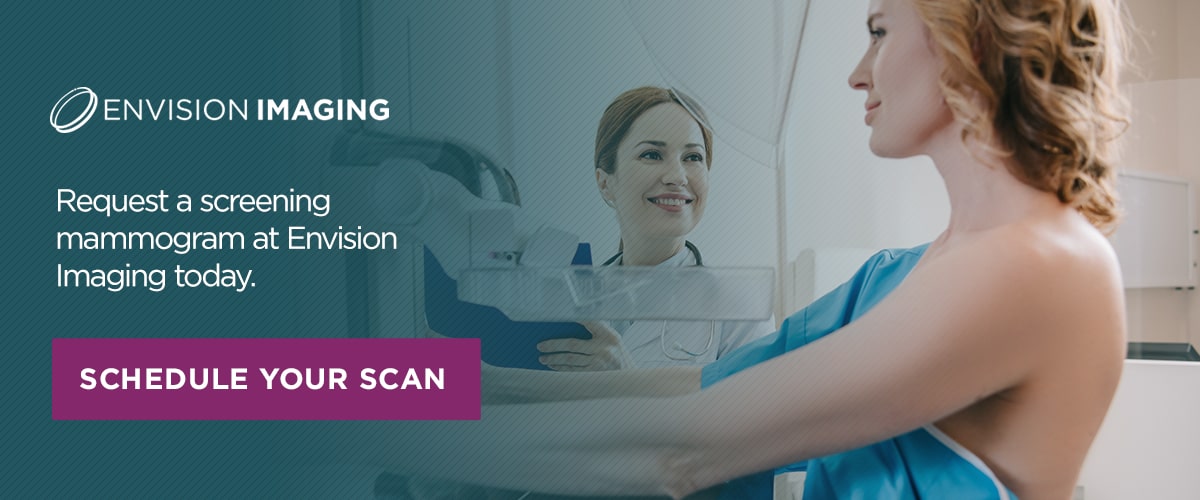Why Your Family’s Medical History Is Important For Breast Cancer
Breast cancer is the second most common cancer among women in the United States. According to the American Cancer Society, the average risk of a woman developing breast cancer is approximately 13%, giving her a 1 in 8 chance of developing the disease in her lifetime.
Numerous factors can contribute to a person’s risk of getting breast cancer, such as:
- Age
- Ethnicity
- Physical characteristics
- Habits
Outside these influences, many individuals wonder if having a family history of breast cancer can increase their risk.
Through this comprehensive guide, we’ll outline the various breast cancer risk factors and explain the likelihood of getting breast cancer based on your family history.
What Are the Different Breast Cancer Risk Factors?
Various risk factors can contribute to the development of breast cancer, each with different effects.
Most women have one or multiple breast cancer risk factors — however, having these characteristics doesn’t necessarily mean you’ll develop the disease. Most women do not develop breast cancer, with only 12.9% of women born in the U.S. projected to get the disease. Conversely, some women will get breast cancer without exhibiting any known risk factors.
Some of the most common breast cancer risk factors include:
- Aging: As individuals get older, they develop a higher risk of getting breast cancer. Most breast cancers get diagnosed in women over age 50.
- Menstrual cycles: Women who start menstruating before age 11 are at a 20% higher risk of breast cancer than those who began at age 14 or older. Experiencing menopause at age 55 or older also puts individuals at a 12% higher risk than those who started between ages 50 and 54.
- Physical inactivity: Individuals who do not participate in regular physical activity have a higher cancer risk than those who exercise.
- Breast density: Women with dense breasts have an increased chance of developing breast cancer. Denser breasts have higher quantities of connective tissue than fatty tissue, making it more challenging for doctors to identify tumors on a mammogram.
- Height: Studies have shown that taller women are more likely to get breast cancer than shorter women, perhaps due to growth differences, genetics or hormonal factors.
- Alcohol consumption: Having one alcoholic drink per day can increase your risk of breast cancer between 7% and 10%, while two to three drinks per day can result in a 20% increase.
- Excess body weight: The risk of getting breast cancer is higher for women who are overweight or obese.
- Hormones: Taking oral contraceptives and menopausal hormones can result in a higher breast cancer risk.
Am I More at Risk If My Relatives Have Breast Cancer?
With breast cancer being the second most common cancer among U.S. women, many women have people in their families who have had breast cancer.
Sometimes, these occurrences happen by chance. Other times, they result from inherited faulty genes, called BRCA1 or BRCA2 gene mutations. Your BRCA1 and BRCA2 genes are tumor suppressor genes responsible for preventing the growth of cancer cells.
When these genes mutate, they stop working properly, raising the individual’s risk of getting cancer. These mutations can be passed through generations of families and can get inherited on either side.
Though these faulty genes result in a higher risk of developing breast cancer, they are much less common than other risk factors. In fact, less than 5% of breast cancer cases are related to inherited genetic faults.
When evaluating your risk of breast cancer, examine both your mother’s and father’s sides of the family.
Families with the inherited gene mutation typically have the following characteristics:
- Women who were diagnosed with breast cancer before age 40
- Women with ovarian cancer
- Women who developed both breast and ovarian cancer
- Women with breast cancer present in both breasts
- Men who developed breast cancer
- Men or women with Ashkenazi Jewish ancestry
What Is My Risk of Developing Breast Cancer?
All individuals fall into one of three risk categories based on their family history of breast cancer.
You can evaluate your risk by determining which category is most applicable to you.
Category 1: At or Slightly Above the Average Risk
About 95% of women fall into this risk category, and 90% of them will not develop breast cancer.
Members of this group either have no family history of breast cancer or a history of the disease occurring in one of the following:
- One first-degree relative aged 50 or older
- One second-degree family member aged 50 or older
- Two first- or second-degree relatives over age 50 on different sides of the family
- Two second-degree relatives ages 50 or older on the same side of the family
Category 2: Moderately Increased Risk
Less than 4% of women fall into the second category of breast cancer risk but have a slightly increased risk compared to those in category 1.
Those with a moderately increased risk of breast cancer have a family history that includes:
- One first-degree family member under 50
- Two first-degree relatives on the same side of the family
- Two second-degree relatives on the same side, with one diagnosed before age 50
Category 3: Potentially High Risk
Fewer than 1% of women fall into this group.
These individuals have two first- or second-degree relatives on the same side of the family with breast cancer, along with one or more additional risk factors:
- Additional relatives with breast or ovarian cancer
- A relative with both ovarian and breast cancer
- A family member with breast cancer in both breasts
- A male family member with breast cancer
- A relative who tested positive for a high-risk BRCA1 or BRCA2 gene mutation
- A family member with breast cancer diagnosed before age 40
- A family with Ashkenazi Jewish ancestry
How Do I Minimize My Risk of Getting Breast Cancer?
Regardless of how high or low your risk of getting breast cancer is, there are various methods you can implement into your lifestyle to monitor and minimize your chances of developing the disease, including:
- Familiarizing yourself with your normal breast shape and consistency
- Contacting a doctor if you notice any breast changes
- Scheduling yearly breast examinations
- Booking screening mammograms every two years between ages 40 and 50
- Exercising more frequently
- Losing weight
- Breastfeeding for a year after giving birth
- Limiting alcohol consumption
- Eating a healthier diet
- Avoiding oral contraceptives and other hormones
If you’re a part of risk category 1 or 2, you can take extra precautions by starting screening mammograms earlier or more frequently or visiting a family cancer clinic to discuss your personal risks in greater detail.
Request a Screening Mammogram at Envision ImagingToday
If you’re looking to monitor your breast cancer risks, consider scheduling a screening mammogram at Envision Imaging.
We specialize in world-class diagnostic imaging and radiology services, helping to enhance our patients’ health and quality of life while delivering the most positive experiences.
Our team understands that every patient has their own unique conditions and circumstances. That’s why we strive to provide the most pleasant and compassionate care to everyone who comes through our doors.
Schedule your mammogram screening with our expert staff today!
Sources
- https://www.cdc.gov/cancer/breast/statistics/index.htm
- https://www.cancer.org/cancer/breast-cancer/about/how-common-is-breast-cancer.html
- https://www.cancer.gov/types/breast/risk-fact-sheet
- https://www.cdc.gov/cancer/breast/basic_info/risk_factors.htm
- https://www.cancer.org/content/dam/cancer-org/research/cancer-facts-and-statistics/breast-cancer-facts-and-figures/breast-cancer-facts-and-figures-2019-2020.pdf
- https://www.cdc.gov/cancer/breast/young_women/bringyourbrave/hereditary_breast_cancer/index.htm
- https://www.bci.org.au/breast-cancer-information/fact-sheets/family-history-breast-cancer/
- https://www.envrad.com/screening-mammogram-request/
- https://www.nhs.uk/common-health-questions/lifestyle/am-i-more-at-risk-if-my-relatives-have-cancer/
- https://www.cancer.org/cancer/breast-cancer/risk-and-prevention/lifestyle-related-breast-cancer-risk-factors.html





